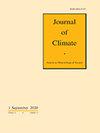气溶胶和云的特征及其在地球能量预算中的作用
IF 4.8
2区 地球科学
Q1 METEOROLOGY & ATMOSPHERIC SCIENCES
引用次数: 0
摘要
摘要 云和气溶胶是估计和解释地球能量预算的最大不确定因素。本研究不仅关注地表增亮/减弱,还探讨了地球的能量平衡。CERES-SYN、ISCCP-FH 和 GEWEX-SRB 数据集与基线地表辐射网络(BSRN)、地表辐射预算网络(SURFRAD)和 CMA 观测数据的验证结果表明,CERES 数据具有最高的精度和最长的时间覆盖范围。利用 CERES 和 MERRA-2 产品解释了云和气溶胶在地球能量预算中的作用。结果表明,2000-21 年间,地球能量以 0.63 W m-2 10 年-1 的速度增加。全球地表以 0.57 W m-2 十年-1 的速率变亮,地表能量以 0.19 W m-2 十年-1 的速率下降。澳大利亚、中亚和非洲南部的地表变亮主要与云量减少有关,气溶胶排放量的减少也是东亚地表变亮的原因之一。南美洲和东南亚地表变亮也是由于云量减少。南亚气溶胶的增加是其地表变暗的主要因素,而我们推断南亚黑碳(BC)气溶胶增加所产生的气候效应是中国南部地表变暗的诱因。西亚的地表变暗是云和气溶胶共同作用的结果,而非洲北部的地表变暗可能与尘埃气溶胶减少导致云增加有关。只有东南亚、南美洲和欧洲的地表能量有所增加。意义说明 云和气溶胶是估计和解释地球不断变化的能量预算的最大不确定因素。此外,云和气溶胶的相对重要性因研究的地区和时间尺度而异。这项研究表明,2000-21 年地球系统的能量流入大于能量流出,地球上的辐射以 0.63 W m-2 10 年-1 的速度增加,地表能量以 0.19 W m-2 10 年-1 的速度减少。在东南亚、南美洲、澳大利亚和非洲南部发现了亮化现象,地表暗化区域主要出现在亚洲和非洲北部。本文章由计算机程序翻译,如有差异,请以英文原文为准。
Characteristics of Aerosols and Clouds and Their Role in Earth’s Energy Budget
Abstract Clouds and aerosols provide the greatest uncertainty in estimating and interpreting Earth’s energy budget. This study not only focuses on surface brightening/dimming, but also explores Earth’s energy balance. The validation results of the CERES-SYN, ISCCP-FH, and GEWEX-SRB datasets with Baseline Surface Radiation Network (BSRN), Surface Radiation Budget Network (SURFRAD), and CMA observations show that CERES data have the highest accuracy and the longest temporal coverage. The role of clouds and aerosols in Earth’s energy budget was explained using CERES and MERRA-2 products. The results show that Earth’s energy increases at a rate of 0.63 W m−2 decade−1 in 2000–21. The global surface brightens at a rate of 0.57 W m−2 decade−1, with surface energy decreasing at a rate of 0.19 W m−2 decade−1. Brightening was found over Australia, central Asia, and southern Africa, mainly associated with cloud reduction, with aerosol emissions reductions contributing to the East Asian surface brightening. The surface brightening in South America and Southeast Asia is also due to the reduction of clouds. The increase of aerosols in South Asia is the main factor for its surface dimming, while we infer that the climatic effect from the increase of black carbon (BC) aerosols in South Asia is the inducing factor for the dimming in southern China. The surface darkening in West Asia is the result of the combined effect of clouds and aerosols, while in northern Africa it may be related to the increase of clouds caused by the decrease of dust aerosols. Surface energy increases only in Southeast Asia, South America, and Europe. Significance Statement Clouds and aerosols provide the greatest uncertainty in estimating and interpreting Earth’s changing energy budget. Moreover, the relative importance of clouds and aerosols is variable, depending on the regions and time scales of studies. This study shows that the energy inflow to the Earth system is greater than the energy outflow in 2000–21, with radiation on Earth increasing at a rate of 0.63 W m−2 decade−1 with the surface energy decreases at a rate of 0.19 W m−2 decade−1. Brightening was found over Southeast Asia, South America, Australia, and southern Africa, with the areas of surface darkening occurring mainly in Asia and northern Africa.
求助全文
通过发布文献求助,成功后即可免费获取论文全文。
去求助
来源期刊

Journal of Climate
地学-气象与大气科学
CiteScore
9.30
自引率
14.30%
发文量
490
审稿时长
7.5 months
期刊介绍:
The Journal of Climate (JCLI) (ISSN: 0894-8755; eISSN: 1520-0442) publishes research that advances basic understanding of the dynamics and physics of the climate system on large spatial scales, including variability of the atmosphere, oceans, land surface, and cryosphere; past, present, and projected future changes in the climate system; and climate simulation and prediction.
 求助内容:
求助内容: 应助结果提醒方式:
应助结果提醒方式:


